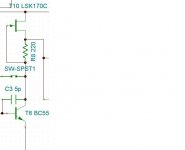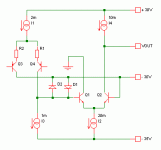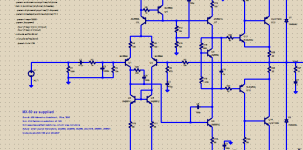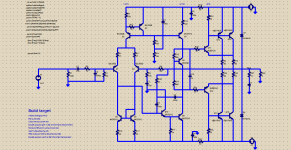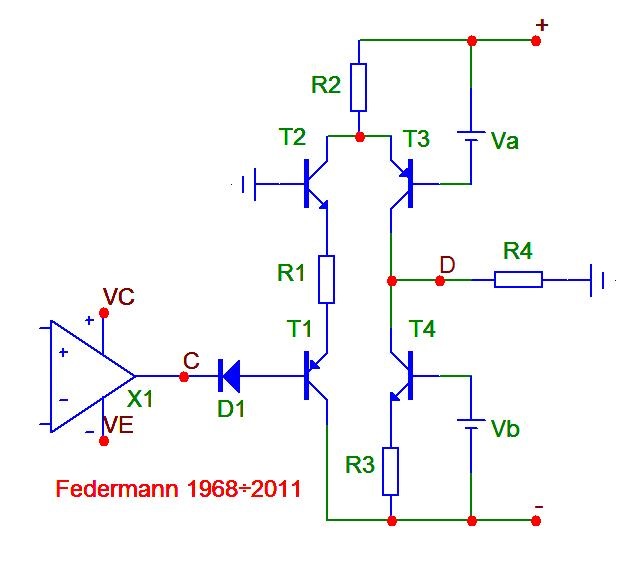Edmond/jcx, what cross over frequency do you normally shoot for with TMC assuming 1281/1382 output stage and an equivalent MC ULG of say 1MHz? I have tried from 500KHz throght to nealy 1MHz without too many problems. However, I will admit I always err well on the side of caution with loop gain and ULG. Interested to know your views.
Hi Bonsai,
500kHz to 1MHz are precisely the transition frequencies I shoot for. 😀
Cheers,
E.
I don't understand follow term in case of different VAS topologies:I was under the impression that you were opposed to high feedback amps.
"high feedback amp"
BTW - I don't like amps with strong NFB's, where is more than one amplifier stage with voltage gain within the NFB loop.
An amp with only one voltage gain stage is to find by post #4 about
http://www.diyaudio.com/forums/soli...ody-burmester-avm-schematics.html#post2598494
The front-end consist of a push pull cascode (folded cascode) - very similar topology as used in OP-amps with very high GBW product.
Last edited:
Link please.
Are you asking me for a link? I don't have one. I invented it myself.
Yeah, sometimes I find a thumb. (from Defying Gravity)
Are you teasing me? Anyhow, may we have a look at the schematic, please?
No, I'm not teasing anyone. I just thought it was simple enough to not need a picture. Here's a portion from a schematic I developed.
Attachments
Most SRPP voltage amplifier stages are to find with tubes. But there are also few versions without tubes. If you use the SRPP power output stage from the attachment as VAS stage (idle current now only between 15 and 30 mA) and add a power (push pull) buffer together with a Vbe multiplier, you will get a power amp with SRPP VAS stage.What about a SRPP VAS?
Unfortunately I haven't experience concerning the sonic character.
Another SRPP example with BjT's you will find by post #3 about
http://www.diyaudio.com/forums/analogue-source/151527-how-convert-creek-obh-8-mc-cartridges.html
After remove the RIAA filter, adding an output power buffer and new calculating for higher main voltage you will get also a power amplifier circuit example with VAS stage.
Attachments
Last edited:
Hi Bonsai,
500kHz to 1MHz are precisely the transition frequencies I shoot for. 😀
Cheers,
E.
Thanks.
Also useful in solid state when you want to swing high output voltage e.g. for electrostatic headphones.Most SRPP voltage amplifier stages are to find with tubes...
I think in a classic Darlington connection to the VAS you talk about Homeodder then Cob indeed is an issue, but the VAS feeding the cascode is a little different. Sims show a very big improvement at HF (both with and without TMC). The whole idea of fixing the collector voltages is so that changes in Vce cannot take place and changes in Vcb are minimal anyway (a few mV) However, I'd be interested to see you findings - I might be missing something here.
Last night just to be sure I dug up my books, looked at the maths which suggest I was on the right path.
Then I did a quick check with LTspice and this confirmed theory and a little hiccup.
The beta enhancer does outperform cascoded darlington at high frequencies, no surprises there for me, its not a vast difference but it is there. At low frequencies the cascoded darlington should show slight better THD figures but it does not in ltspice, comes up as =.
Last edited:
I don't understand follow term in case of different VAS topologies:
"high feedback amp"
BTW - I don't like amps with strong NFB's, where is more than one amplifier stage with voltage gain within the NFB loop.
An amp with only one voltage gain stage is to find by post #4 about
http://www.diyaudio.com/forums/soli...ody-burmester-avm-schematics.html#post2598494
The front-end consist of a push pull cascode (folded cascode) - very similar topology as used in OP-amps with very high GBW product.
The memory distortion type topology has very high loop gain requiring high feedback. Nothing to worry about though Ive listened to one of these amps, they sound amazingly good.
I was planning to investigate that avm over the weekend, with just 2 extra transistors and couple of diodes its possible to transform that vas s dismall linearity. Folded cascode is not very linear and when you look closer at the opamps using them in push pull youll also find a couple of feedforward networks to get better linearity out of them.
I don't understand follow term in case of different VAS topologies:
"high feedback amp"
BTW - I don't like amps with strong NFB's, where is more than one amplifier stage with voltage gain within the NFB loop.
An amp with only one voltage gain stage is to find by post #4 about
http://www.diyaudio.com/forums/soli...ody-burmester-avm-schematics.html#post2598494
The front-end consist of a push pull cascode (folded cascode) - very similar topology as used in OP-amps with very high GBW product.
You need to wander over to the PASS forum. You will find a lot of ideas on amps without high global feedback. A lot on class A too.
In my playing with the MX-50 in Spice, I found the darlington to sim vastly better than the simple cascode. Changing to TMC helped the high end distortion. I was keeping the changes minimal as I am using the boards that came. If you are doing your own boards, a lot is opened up. When I find a transformer, I am going to put it together. I was thinking about converting a DH-220 into a test power supply with adjustable regulators for VAS. Yes, it seems a shame to cut up a good amp, but it is cheaper than building a supply. I figure I can recover most of my cost by selling the output transistors. Maybe I should buy a crappy amp to cut up instead.
Tvr, now try this get rid of cascode and just use a beta enhanced vas as Self proposes, this is what we were discussing. When you did comparison did you keep such trivial parameters like vas currents the same ??? When investigating its preferable to isolate the stage not sim it in circuit.
Btw what does this MX 50 look like ??
Btw what does this MX 50 look like ??
What about using the JLH topology (the 2005 Rev.) as an amplifier's frontend? Has anybody tried this before?
Tvr, now try this get rid of cascode and just use a beta enhanced vas as Self proposes, this is what we were discussing. When you did comparison did you keep such trivial parameters like vas currents the same ??? When investigating its preferable to isolate the stage not sim it in circuit.
Btw what does this MX 50 look like ??
Yes, isolating helps. When I was playing with my DH-120 I could not see any differences in IPS changes because they were totally swamped by VAS and output issues. That is itself is informative. See if your distortions are even or odd and that leads you to the correct stage to work on.
Attachments
To make it easy for a beginner like me, what page is the VAS you are suggesting, assuming in his book. Or if Cordell, or a link, or....
I have seen references to beta enhanced cascode, and am not sure what that is meant to be. What is interesting is that what work in one sim sometimes totally fails in another. I have not been able to get a Wilson current mirror to work. I tried a current mirror CCS for a VAS in the MX-50 and could not get it working, yet it was virtually identical to every other. I am clearly messing something up. If I can't get it stable on paper, I don't want to pay tribute the gods of silicone yet. "Apply power and tune for minimum smoke".
I have seen references to beta enhanced cascode, and am not sure what that is meant to be. What is interesting is that what work in one sim sometimes totally fails in another. I have not been able to get a Wilson current mirror to work. I tried a current mirror CCS for a VAS in the MX-50 and could not get it working, yet it was virtually identical to every other. I am clearly messing something up. If I can't get it stable on paper, I don't want to pay tribute the gods of silicone yet. "Apply power and tune for minimum smoke".
- Status
- Not open for further replies.
- Home
- Amplifiers
- Solid State
- Best VAS?
